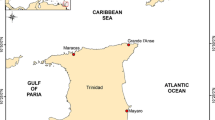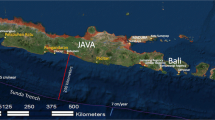Abstract
A survey of over 300 residents’ and visitors’ (non-residents) perceptions of tsunami hazards was carried out along the west coast of Washington State during August and September 2001. The study quantified respondents’ preparedness to deal with tsunami hazards. Despite success in disseminating hazard information, levels of preparedness were recorded at low to moderate levels. This finding is discussed in regard to the way in which people interpret hazard information and its implications for the process of adjustment adoption or preparedness. These data are also used to define strategies for enhancing preparedness. Strategies involve maintaining and enhancing hazard knowledge and risk perception, promoting the development of preparatory intentions, and facilitating the conversion of these intentions into sustained preparedness. A second phase of work began in February 2003, consisting of a series of focus groups which examined beliefs regarding preparedness and warnings, and a school survey. Preliminary findings of this work are presented.
Similar content being viewed by others
References
B. F. Atwater (1992) ArticleTitleGeologic evidence for earthquakes during the past 2000 years along the Copalis River, southern coastal Washington. J. Geophys. Res 97 IssueIDB2 1901–1919
B. F. Atwater A. R. Nelson J. J. Clague G. A. Carver D. K. Yamaguchi P. T. Bobrowsky J. Bourgeois S. P. Palmer et al. (1995) ArticleTitleSummary of coastal geologic evidence for past great earthquakes at the Cascadia subduction zone Earthquake Spectra. 11 1–18
P. Bennett S. Murphy (1997) Psychology and Health Promotion. Open University Press Buckingham
Bernard, E. N.: 2001, The U.S. National Tsunami Hazard Mitigation Program Summary. In: Proceedings of the International Tsunami Symposium 2001 (ITS 2001) (on CD-ROM), NTHMP Review Session, R-1, Seattle, WA, 7–10 August 2001, pp. 21–27. http://www.pmel.noaa.gov/its2001/.
J. Browne G. Sullivan (1999) Analysing in-depth interview data using grounded theory V. Minichello G. Sullivan K. Greenwood R. Axford (Eds) Handbook for Research Methods in the Health Sciences. Addison-Wesley Sydney 575–611
K. Chamberlain (1999) Using grounded theory in health psychology. M. Murray K. Chamberlain (Eds) Qualitative Health Psychology: Theories and Methods. Sage Publications London 183–201
J. H. Dalton M. J. Elias A. Wandersman (2001) Community Psychology. Wadsworth Belmont, CA
C. E. Gregg B. F. Houghton D. M. Johnston D. Paton D. Swanson (2004) ArticleTitleThe perception of volcanic risk in Kona communities from Mauna Loa and Hualalai volcanoes Hawaii. J. Volcanol. Geotherm. Res 130 IssueID3–4 179–196
K. L. Henwood N. F. Pidgeon (1992) ArticleTitleQualitative research and psychological theorizing J. Psychol. 83 97–111
D. M. Johnston M. S. Bebbington C.-D. Lai B. Houghton D. Paton (1999) ArticleTitleVolcanic hazard perceptions: Comparative shifts in knowledge and risk Disaster Prev. Manage. 8 118–126
D. M. Johnston K. Benton (1998) ArticleTitleVolcanic hazard perceptions in Inglewood, New Zealand. Aust. J. Disaster Trauma Stud 2 1–8
Johnston, D. M., Driedger, C., Houghton, B., Ronan, K., and Paton, D.: 2001, Children’s risk perceptions and preparedness: A hazard education assessment in four communities around Mount Rainier, U.S.A.–Preliminary results. Institute of Geological and Nuclear Sciences Science Report 2001/02.
D. M. Johnston B.F. Houghton (1995) ArticleTitleSecondary school children’s perceptions of natural hazards in the central North Island New Zealand J. Geogr. 99 18–26
Johnston, D. M., Paton, D., Houghton, B., Becker, J., and Crumbie, G.,: 2002, Results of the August–September 2001 Washington State Tsunami Survey. Institute of Geological and Nuclear Sciences Science Report 2002/17, 35 pp.
Jonientz-Trisler, C. and Mullin, J.: 1999, 1997–1999 Activities of the Tsunami Mitigation Subcommittee: A Report to the Steering Committee NTHMP. FEMA Region 10 publication, 45 pp., Appendices.
M. K. Lindell D. J. Whitney (2000) ArticleTitleCorrelates of household seismic hazard adjustment Risk Anal. 20 13–25
J.-P. Mulilis T. Duval R. Lippa (1990) ArticleTitleThe effects of a large, destructive local earthquake on earthquake preparedness as assessed by an earthquake preparedness scale Nat. Hazards 3 357–371
J.-P. Mulilis T. S. Duval (1995) ArticleTitleNegative threat appeals and earthquake preparedness: A person-relative-to-event (PrE) model of coping with threat J. Appl. Soc. Psychol. 25 1319–1339
D. Paton (2000) ArticleTitleEmergency Planning: Integrating community development, community resilience and hazard mitigation. J. Am. Soc. Prof. Emerg. Manage 7 109–118
D. Paton (2003) ArticleTitleDisaster preparedness: a social-cognitive perspective Disaster Prev. Manage. 12 210–216
D. Paton M. Millar D. Johnston (2001) ArticleTitleCommunity resilience to volcanic hazard consequences Nat. Hazards 24 157–169
Paton, D., Smith, L., Johnston, D., Johnston, M., and Ronan, K.: 2003a, Developing a model to predict the adoption of natural hazard risk reduction and preparatory adjustments. EQC Project Report, No. 01–479, Wellington, Earthquake Commission, New Zealand.
Paton, D., Smith, L. M., and Johnston, D.: 2003b, When good intentions turn bad: Promoting disaster preparedness. In: Proceedings of the 2003 Australian Disaster Conference, Mt. Macedon, Victoria.
K. R. Ronan D. M. Johnston (2001) ArticleTitleCorrelates of hazard education programs for youth Risk Anal. 21 1055–1063
K. R. Ronan D. M. Johnston (2003) ArticleTitleHazards education for youth: A quasi-experimental investigation Risk Anal. 23 IssueID5 1009–1020
A. Strauss J. Corbin (1990) Basics of Qualitative Research: Grounded Theory Procedures and Techniques. Sage London
Walsh, J., Caruthers, C. G., Heinitz, A. C., Myers, E. P., Baptista, A. C., Erdakos, G. B., and Kamphaus, R. A.: 2000, Tsunami Hazard Map of the Southern Washington Coast: Modeled Tsunami Inundation from a Cascadia Subduction Zone Earthquake. Washington Division of Geology and Earth Resources Geological Map GM-9.
Wilson, B. W. and Torum, A.: 1972, Runup heights of the major tsunami on North American coasts. In: National Research Council Committee on the Alaska Earthquake, 1972, The great Alaska Earthquake of 1964 – Oceanography and Coastal Engineering, pp. 3158–3180.
Author information
Authors and Affiliations
Corresponding author
Rights and permissions
About this article
Cite this article
Johnston, D., Paton, D., Crawford, G.L. et al. Measuring Tsunami Preparedness in Coastal Washington, United States. Nat Hazards 35, 173–184 (2005). https://doi.org/10.1007/s11069-004-2419-8
Received:
Accepted:
Issue Date:
DOI: https://doi.org/10.1007/s11069-004-2419-8




